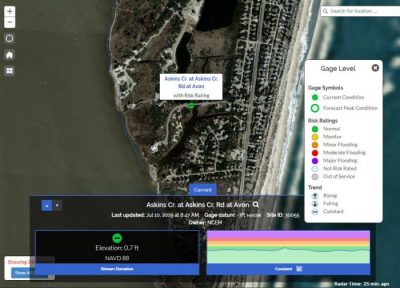
Reprinted from Island Free Press
There are a number of routine questions that arise with every weather event where high winds and coastal flooding are an imminent concern – “Do I need to move my car? What about my lawnmower? Do I need to take all my outside stuff indoors?”
Supporter Spotlight
There’s a relatively new online tool to help find immediate answers to these questions – the local flood gauges that are installed and monitored by the Flood Inundation Mapping and Alert Network, or FIMAN.
The first four were installed in 2018 at the emergency ferry dock in Rodanthe, the North Carolina Center for the Advancement of Teaching campus in Ocracoke, the Coast Guard station in Hatteras and at the Oregon Inlet Marina.
There have been more added as FIMAN expands its reach to provide a state network that alerts local communities to dangerous flooding conditions.
A new flood gauge popped up in the Askins Creek neighborhood of Avon earlier in 2019, and plans are in the works to add another flood gauge at the Fessenden Center in Buxton.
“Hopefully, the one at the Fessenden Center will be installed at the end of July or early August,” said Drew Pearson, emergency management director for Dare County. “Having one in every village and every town would be my hope, and we’re hoping to continue to beat the drum to get them installed so residents can say ‘This one is in my village and my community, so I can look at this gauge for information.’”
Supporter Spotlight
The public can access any of the flood gauges using the online interactive map and use the color-coded information to determine the current risk of minor, moderate, or major flooding for their area.

Users can register to receive email or text alerts when flooding reaches dangerous levels, and can also see an overview of what is considered “normal” for a flood gauge.
The information is constantly being updated with real-time data, so when a storm is on the horizon, islanders can follow water local water levels and proceed accordingly.
“Anyone who wants to know how much water is in the sound at any particular point in time can take a look at the water levels and see how much is there,” said Pearson. “When waters are on the rise, anyone can see the sound levels coming up, and the higher it gets, the more likely it is that there will be flooding … And you can see that in real time with the gauges that are being installed.”
While the gauges don’t forecast what might come next, the real-time ebb and flow of water levels provides snapshot of what’s happening and can help guide any appropriate next steps.
“This will give people the opportunity to be alerted that water levels are changing, and it can help them make decisions when there are warnings in place,” said Pearson. “There might be an event where people see the water levels rising, so they know they need to move their car, or clean up their yard.”
This story is provided courtesy of the Island Free Press, a digital newspaper covering Hatteras and Ocracoke islands. Coastal Review Online is partnering with the Free Press to provide readers with more environmental and lifestyle stories of interest along our coast.







